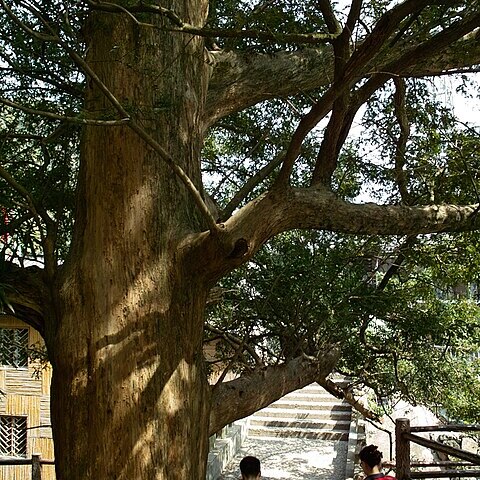Trees to 25 m tall; trunk to 0.5(-2) m d.b.h.; bark light yellowish gray, dark gray, or grayish brown, with irregular vertical fissures. Leafy branchlets oblong-obovate in outline, 4-7 × 2.5-4 cm, axis green and glabrous in 1st year, thereafter yellowish green, light brownish yellow or pale brown. Leaves borne at (50-)60-90° to branchlet axis; petiole 0.5-1 mm; blade bright green and glossy adaxially, linear-lanceolate, usually straight, (0.7-)1.1-2.5(-4.5) cm × 2-3.5 mm, with no conspicuous grooves, midvein indistinct adaxially, (0.2-)0.5-0.7 mm wide abaxially, stomatal bands (0.2-)0.3-0.4 mm wide, marginal bands 0.5-0.7 mm wide, base obtuse or broadly rounded, ± symmetric, margin flat or very narrowly revolute, apex symmetrically or slightly asymmetrically tapered, cuspidate, cusp 0.3-1 mm. Pollen cones columnar, ca. 8 mm; bracts conspicuously ridged. Aril pale purplish brown and white powdery when ripe, apex obtuse-rounded or rounded and cuspidatae. Seed ellipsoid to ovoid, elongate-ellipsoid, obovoid, or obovoid-conical, 2-4.5 × 1.2-2.5 cm; female gametophyte tissue slightly wrinkled, not ruminate. Pollination Apr, seed maturity Sep-Nov of 2nd year.
More
A tree which grows up to 25 m tall. Several different cultivated varieties occur. The trunks are 55 cm across. The leaves are arranged in spirals. They appear to be in 2 layers The are narrow and rigid. They are 1-2.5 cm long and 2-4 mm wide. The end in a sharp point. The flowers are of one sex and plants are separately male and female. The seed is oval and 2-4.5 cm long by 1.5-2.5 cm wide. There is a thin fleshy outer coat and a woody inner coat.
An understorey tree, occasionally reaching the canopy, in mixed forests; commonly found along streams or in shady spots in the forest. Sometimes found in secondary vegetation, but not persisting; at elevations from 200-1,400 metres.
More
It is a temperate plant. It suits hardiness zone 6.


